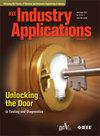Analysis and Multi-Objective Optimization of the Hybrid Excitation Switched Flux Machine
IF 4.2
2区 工程技术
Q2 ENGINEERING, ELECTRICAL & ELECTRONIC
引用次数: 0
Abstract
In this paper, a model-based multi-objective optimization method is proposed for the hybrid excitation switched flux (HESF) machine. In the proposed method, the index space distribution including torque index and flux index, which are highly related with the average torque and flux regulation capability, can be fast obtained by a simple magnetic circuit model, and then only these pareto front designs of the index space are calculated by finite element (FE). Hence, compared with the conventional pure FE-based multi-objective optimization, the optimization time of the proposed model-based multi-objective optimization is much smaller, e.g., 67 hours to 2.3 hours for the studied 12-slot/10-pole HESF machine on a desktop with 64 GB RAM and Intel Core i9-10900F CPU. In addition, in the high dimensional optimization the pure FE based optimization will easily crowd and stuck around many local optimum points due to flux-leakage and local magnetic saturation, whilst the proposed model-based optimization captures the main magnetic path characteristics, which can efficiently find better designs in a reasonable time. In this paper, the pareto front obtained from the proposed model-based optimization method contains better designs than that of the pure FE-based optimization method. A machine prototype is built and tested to validate the proposed model-based multi-objective optimization method in this paper.混合励磁开关磁通机的分析与多目标优化
本文针对混合励磁开关磁通(HESF)机器提出了一种基于模型的多目标优化方法。在该方法中,包括与平均转矩和磁通调节能力高度相关的转矩指数和磁通指数在内的指数空间分布可以通过一个简单的磁路模型快速获得,然后只对这些指数空间的帕累托前沿设计进行有限元(FE)计算。因此,与传统的纯 FE 多目标优化相比,基于模型的多目标优化所需的优化时间要短得多,例如,对于所研究的 12 插槽/10 极 HESF 机器,在 64 GB 内存和英特尔酷睿 i9-10900F CPU 的台式机上,优化时间从 67 小时缩短到 2.3 小时。此外,在高维优化中,由于磁通泄漏和局部磁饱和,基于纯 FE 的优化很容易挤占和卡住许多局部最优点,而基于模型的优化能捕捉到主要磁路特征,从而能在合理的时间内高效地找到更好的设计。与纯粹的基于 FE 的优化方法相比,本文提出的基于模型的优化方法得到的帕累托前沿包含更好的设计。为了验证本文提出的基于模型的多目标优化方法,我们制作并测试了一台机器原型。
本文章由计算机程序翻译,如有差异,请以英文原文为准。
求助全文
约1分钟内获得全文
求助全文
来源期刊

IEEE Transactions on Industry Applications
工程技术-工程:电子与电气
CiteScore
9.90
自引率
9.10%
发文量
747
审稿时长
3.3 months
期刊介绍:
The scope of the IEEE Transactions on Industry Applications includes all scope items of the IEEE Industry Applications Society, that is, the advancement of the theory and practice of electrical and electronic engineering in the development, design, manufacture, and application of electrical systems, apparatus, devices, and controls to the processes and equipment of industry and commerce; the promotion of safe, reliable, and economic installations; industry leadership in energy conservation and environmental, health, and safety issues; the creation of voluntary engineering standards and recommended practices; and the professional development of its membership.
 求助内容:
求助内容: 应助结果提醒方式:
应助结果提醒方式:


